Virtual Reality Active Games as a Potential Tool to Enhance Movement Skills and Promote Participation in Physical Activities for Children with DCD: Pilot Study -Juniper Publishers
Global Journal of Intellectual & Developmental Disabilities (GJIDD)
Children with developmental coordination problems
exhibit difficulties performing even seemingly simple motor tasks,
discouraging them from engaging in age appropriate physical activities.
It appears that playing active video games may have a positive impact on
certain aspects of their motor performance and the willingness to be
physically active. The purpose of the present pilot study was to examine
if these positive effects can be evident in two children with
Developmental Coordination Disorder (DCD) playing selected Xbox Kinect
sports games. One eleven year old boy and a nine year old girl,
diagnosed with DCD, were assessed using Movement Assessment Battery for
Children (MABC2) and selected components of Bruininks Oseretsky Test
(BOT2) at pre, mid, and post sessions, and two weeks after the program.
Children engaged in Wake Racing, Climbing, Soccer, and Tennis games, in
two 40-minute sessions per week, for 6 weeks. The parents and the
children were also involved in an interview at the end of the study. The
results from the formal assessment tools showed that both children
improved in balance and ball skills subsections of the MABC2. However,
the data from BOT2 failed to show the expected effects on running speed
and agility, and in the strength domain. The interviews with children
revealed that playing games was enjoyable and could potentially affect
their willingness to take part in active play. This was confirmed by
parents, who also were interested in implementing this protocol within
the home setting. However, the degree to which the skills
acquired/refined while playing active video games transfer to real-life
tasks requires further investigation.
Keywords: Developmental coordination disorder; Innovative clinical treatment; Movement skills; Motor abilities Introduction
Video games undeniably represent one of the most
popular sources of entertainment for children and adults of all ages.
They are available on a large spectrum of systems, from consoles
accompanied to televisions, hand held devices, and mobile phones. In
fact, 32% of 2-7 year olds and 65% of 8-18 year olds in America have
television sets accompanied with some sort of video games [1].
This is troublesome for many health professionals who rightly perceive
the engagement in such games as yet another barrier to being active,
particularly for children [2].
Nevertheless, despite these concerns research has shown that if the
games involve active movements they may actually have positive effects
on the acquisition or relearning of certain motor skills [3].
This is not to say that video-games will or should replace the time
spent engaging in active and meaningful physical activities. However,
these games offer an opportunity to learn the basic movement skills in
an environment that is non–threatening, fun, supportive and engaging.
Thus, such games may represent a temporary but valuable alternative for
individuals who are often unwilling to engage in active play/activities
due to their low skill or fitness levels and coinciding low perceptions
of competency and feelings of social unaptness.
From the clinical perspective, implementation of
active virtual games (Sony's PlayStation, Nintendo Wii, and Microsoft
Xbox Kinect) constitutes a useful approach as many individual, task and
environmental constraints can be altered to assure success. Also, the
fact that the performer has the opportunity to practice a number of
distinctive skills, or perform a singular skill under different task
and/or environmental-virtual conditions, is conceptually relevant. The
former condition is synonymous with the premise of contextual
interference [4], whereas the former approach is in line with schema theory and variability of practice hypothesis [5],
two of the most robust concepts in contemporary motor learning
literature. It has been also suggested that the implementation of
virtual games may stimulate implicit learning and positively affect the
variety of perceptual motor domains which otherwise would be difficult
to enhance if the child was unwilling to take part in any physical
activity [6]. These positive effects have been evident in studies involving children with Down syndrome [7], attention deficit hyperactivity disorder (ADHD) [8] and those without any known medical conditions but who are overweight [9].
Also, there has been some initial research carried out with children
diagnosed with Developmental Coordination Disorder (DCD), however the
results remain equivocal.
Children with DCD account for 6 to 10% of school aged
children and exhibit movement problems that are due to factors other
than known medical conditions or intellectual disability [9]. Also, they exhibit motor learning difficulties [10]
which prevent them from acquiring or mastering different motor
abilities (e.g. agility, strength, hand-eye coordination), as well as
fundamental (e.g. throwing, catching, balancing) and specialized
movement skills (e.g. activities of daily living). Due to these movement
constraints they exhibit repeated failures when performing even
seemingly simple tasks. As a result, they often are ridiculed and
bullied, becoming reluctant to participate in physical activities in
socially relevant contexts (school, playground; sport settings). This
further deteriorates their movement repertoire and jeopardizes their
chances of meaningful interaction with their peers [11].
In regards to children with DCD and virtual active
games the existing research is valuable, but still relatively limited.
Gonsalves [12]
reported that when engaged in the active video games children with DCD
carried out the tasks differently when compared to their typically
developing peers. This is a positive Instrumentation finding as it
indicates that the activity affords the participant to explore different
and possible adaptive movement patterns to accomplish the task at hand.
In terms of the other investigations, some failed to show the expected
positive effects [13] whereas others revealed that virtual games may in fact constitute an effective clinical tool [14-16].
Among the different aspects of motor functioning there is a robust
trend showing that playing active video games has a positive effect on
balance control. Also, the anecdotal reports from parents indicated that
participation in these games positively transferred to children's
ability to play ball games and perform agility and strength related
playground skills [17].
However, the available research is still limited as the scope of
previous studies focused primarilyon Nintendo's Wii games. Thus it is
plausible that different types of virtual reality active games may have
positive effects on aspects of motor functioning, other than balance
control. Also, a more in depth qualitative analysis of parents' and
children's perceptions of the effectiveness and applicability of such
approach may provide useful information to researchers and clinicians.
As a result, the first purpose of this study was to examine if playing
active virtual motion Xbox Kinect games had positive effect on balance
control, ball skills, agility and strength in two children with DCD. The
secondary objective was to infer whether participation in such games
was enjoyable and motivating, based on the perceptions of the children,
and if this approach was effective and worth implementing at home, as
inferred from parents.
Materials and Methods
Participants
One male (11 years of age) and one female (9years of
age), diagnosed with DCDby a qualified health professional, were
recruited via purposive sampling. They did not exhibit vision problems
(e.g. required prescription lenses), and had no previous experience with
active virtual games. Also, in order to take part, the parents were
asked to refrain their children from any other clinical programs for the
duration of the study.
Instrumentation
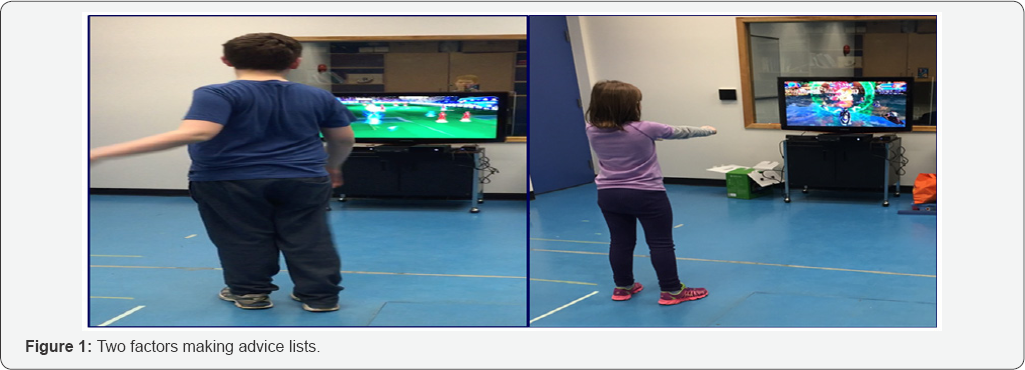
Kinect system for Microsoft's Xbox 360(Microsoft Inc,
Redmond, Washington, USA) was implemented. The user stood facing the
TV-screen where the virtual gaming environment was displayed. In this
video-capture technology the user does not need any other game
controller than naturalistic body movements. A video camera plugged into
the gaming console placed a real-time 3D image of the user inside the
simulated environment where he/she can move around and interact with
virtual objects (Figure 1).
Four games were utilized in this study. The game of Tennis involved
intercepting and striking the ball thus training one's hand/eye
coordination and perceptual- motor integration. The second game was
soccer requiring the participant to manoeuver the body to correctly time
a kick when the ball was approaching. It is a full body movement
involving inter-segmental coordination between the upper and lower body.
In the Wake Racing game the participant was represented on the screen
as sitting on a Seadoo. The child was required to balance his/her body
to manoeuvre the Seadoo around the track. The last game played was
Climbing, where the child had to maintained the arms above the head and
simultaneously grab for the next hand hold and pull down with the
opposite hand to scale the wall. The child was also required to jump to
grab for higher hand holds. This game constrained the participant to
implement strength, stamina and agility.
Outcome measures
The Movement Assessment Battery for Children (MABC-2) [18]
was used to examine the proficiency in balance control and interceptive
ball skills. Manual dexterity was not examined as conceptually there is
no link between the activities undertaken and the child's ability to
perform fine motor skills. The balance control section was comprised of
three items (one-leg standing; walking on the line; jumping) while
aiming and catching included two tasks, one related to the respective
domain. Each raw score was transformed into a standard score for each
task. Generally, the sum of all eight items can be utilized to derive a
total standard score and a percentile score. However for this study,
only individual standard scores for each section were used as manual
dexterity was not tested.
Selected subsections of Bruininks Oseretsky test of motor proficiency (BOT2) [19]
were also implemented. The BOT2 encompasses a large spectrum of fine
and gross motor skills, however for the purpose of this study only
running speed and agility as well as strength sub-sections were
considered. Both the running speed and agility and strength portions of
the test consist of five tasks. The raw point score for each task was
converted into total point score, which was subsequently converted into a
scale score.
Qualitative interview
A semi-structured interview was conducted with both
parents and children. A thematic (deductive) interview approach was
implemented, utilizing open-ended questions. When interviewing the
parents, three main areas of interest were identified. First, the
potential changes in the exercise habits of the children were explored.
Also, the impact that the intervention had on the child's motivation to
participate in physical activity in general, and overall enjoyment of
active gaming was inferred. Lastly, the parents were asked about their
perception of the usefulness of this approach and the potential to its
implementation within the home setting. The interviews lasted
approximately 45 minutes.
Procedure

The study consisted of six phases (Table 1).
In Phase 1, MABC and BOT2 were implemented, as baseline measures. In
Phase 2, each participant attended 60-minute sessions twice a week for a
period of six weeks, involving virtual games on the Xbox Kinect
utilizing the Kinect Sports Rivals game. The primary researcher oversaw
all the sessions. The Xbox Kinect system was the training tool. Twenty
minutes were allotted for tennis, soccer, wake racing, and climbing
games. The same measures that were taken during Phase 1 were
administered once again at the three-week mark representing a
mid-assessment session (Phase 3). Phase 4 involved additional 3 weeks of
intervention, and post-test (Phase 5) was implemented at the end of
this time period once again using MABC and BOT2 tests. The retention
test (Phase 6) was implemented to infer whether the changes in
performance, as inferred from the formal assessment tests, were
permanent. Also, qualitative interview with both the child and parents
took place during this phase Table 1.
Design and data analysis
A case study approach was utilized, with testing time
(pre–assessment, mid-assessment, post-assessment, and retention test)
as the independent variable. The dependent variables were the scores
gathered through the implementation of the MABC-2 and BOT-2 tests across
the different phases of the study. In both tests higher scores
represented better performance. Also, the information gathered through
the qualitative interviews was utilized to infer the potential effects
of gaming on psychological constructs such as motivation and enjoyment.
Results
Outcome data
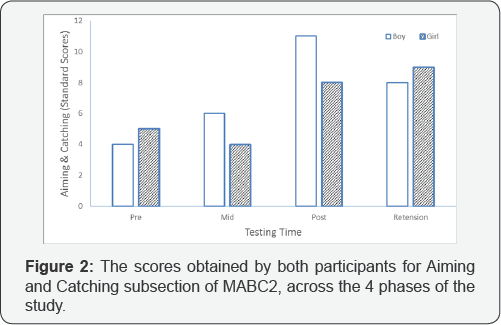
The standard scores from MABC-2 were used to infer
the potential changes in two areas of motor proficiency. In terms of
ball skills, as evident from the pre-test data (Figure 2), both children exhibited low skill level. The scores of 4 and 5 coincide with 2nd and 5th percentile respectively, according to the norms provided in the manual [18].
At the post-test, the scores increased considerably, particularly for
the male participant whose standard score of 11 corresponds to 63rd percentile. A similar scenario was evident in the performance of the female whose score of 8 placed her at 25th
percentile. As evident from the retention test, the enhanced
performance was relatively permanent as the scores although lower for
the male, were still considerably higher as compared to their initial
ball skill status.
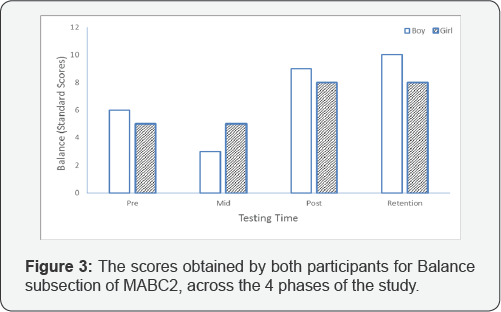
The analysis of balance scores (Figure 3)
showed a similar scenario as compared to the aiming and catching
domain. As evident, both children exhibited scores that would place them
at/around the 6thpercentile at the pre-test, indicating low skill
level. However, the data collected at the post-test showed a substantial
increase in their balance skills, placing them at 63rd and 25th
percentile, respectively. The retention test supported that these
improvements were permanent.

In order to infer if active video games had an impact
on different aspects of motor performance, namely, strength and running
speed/agility, two subsections of Bruinkins test were implemented. The
scores (Figure 4)
showed an equivocal scenario. As evident at the pre-test, the male
participant was slightly more capable in the two domains as compared to
the female, but both were relatively stable across the two areas.
Considering that 52 and 42 are the highest possible scores for running
speed/agility and strength, respectively, it is evident that both
children exhibited a low skill level in these domains. At the mid- and
post sessions, aside from the running and agility score for the male,
the other values remained relatively comparable to those achieved at the
pre-test. The examination of the retention scores confirmed that the
performance was not enhanced as compared to the pre- and post-tests'
scores.
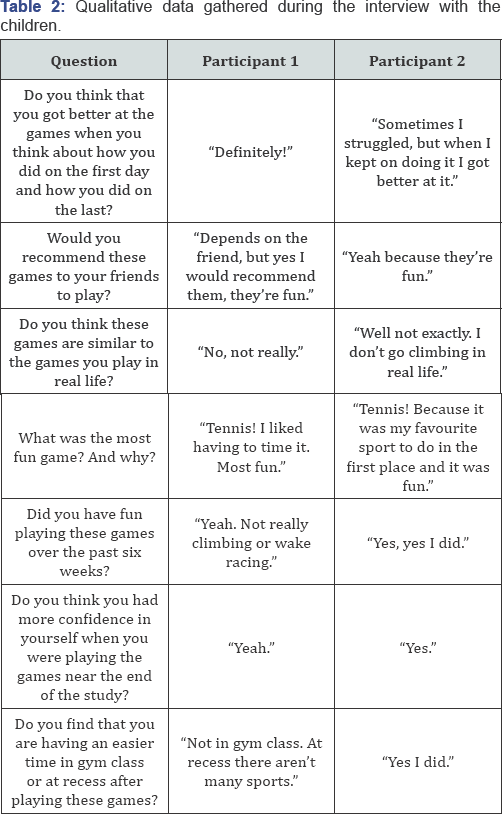
In order to infer if the children and parents
perceived this kind of approach as effective and promising for the
future implementation, interviews involving open-ended questions were
carried out. The information conveyed by the children is presented in Table 2, whereas the information gathered from the parents is presented in Table 3.
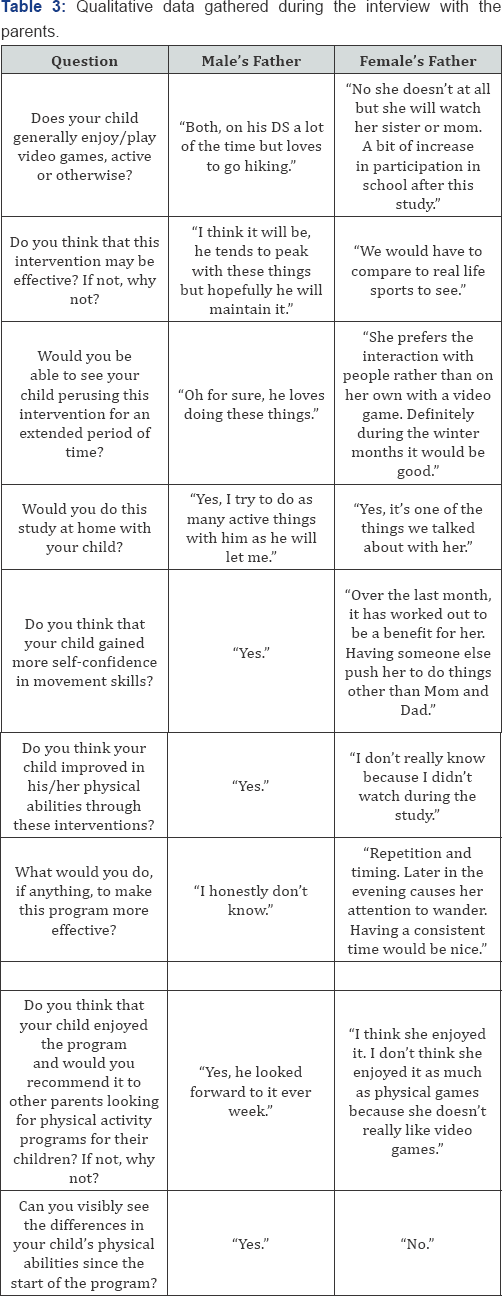
Discussion
Outcome data
The objective of the current pilot study was
two-fold. The first was to examine the effects of playing active virtual
motion (Xbox Kinect) on balance control, agility and performance of
core movement skills in two children diagnosed with Developmental
Coordination Disorder. The emerging results were mixed.
The analysis of MABC-2 scores showed substantial
improvements in ball skills and balance control for both children. In
terms of the first domain, when the normative data was reviewed it was
evident that both children improved from being below 10 percentile to
63rd and 25th respectively, as inferred from MABC-2 norms. Even when
considering the measurement error associated with individual
sub-sections, such change in scores has to be considered as "real" These
positive changes were seen gradually over the initial part of the
study, and then at the retention tests confirming that these
improvements were relatively permanent. Intuitively, when considering
the nature of the games being played (e.g. tennis), generating such
actions effectively does force the player to implement good hand-eye
coordination, interceptive (timing) skills and suitable intra-limb
coordination between the different joints of the arm involved. All these
underlying abilities are also critical in manual skills regardless if
they are occurring under external time demands (e.g. catching) or are
self-paced (e.g. aiming and throwing). Thus, the implementation of the
tasks included in MABC-2 allows to make inferences in regards to the
generalizability/transferability of the skills practiced via virtual
games to real-life tasks. These results do not confirm previous findings
[13,14,16],
which showed no substantial changes in this domain as inferred from
MABC-2. However, it should be noted that these investigations
implemented a Wii Fit program, whereas this study involved Xbox system.
It is plausible that the degree to which the virtual games are effective
may be constrained by the type of the games played, as well as the
technology used. The games available in the market vastly differ in
terms of type of movements they allow and the nature of the interaction
with the screen and surrounding environment [20].
The inferences emerging from the ball skills were in
line with those involving balance control tasks. Both children were
positively affected by the virtual games played, and considering their
nature it can be speculated that soccer and wake racing activities
contributed to these improvements. Although conceptually balance control
is a specific skill rather than a general motor ability [21],
the changes in MABC-2scores were not surprising since the tasks
involved in the test (e.g. standing on one foot) are comparable to those
involved in the games (e.g. standing on one leg while attempting to
kick the virtual ball). In relation to previous research involving
balance control tasks/ measures once again the inferences were mixed.
Straker et al. [13]
showed no changes in balance control as inferred from MABC and COP
measures. However, the expected effects were evident in the studies by
Jelsma and colleagues involving static [16] and dynamic balance tasks [22], as well as in other studies showing improved balance control as measured via MABC-2 and BOT-2 tests [14].
Collectively, it appears that among all the motor domains that are
possibly affected by the virtual games, regardless of the type of the
game or the system implemented, the positive effects on balance control
are robust across majority of the studies.
The analysis of the BOT-2 scores, in regards to
strength and running speed/agility, showed a different scenario. The
review of the scores (Figure 4)
showed that both children varied greatly across the testing sessions,
even if the male participant was performing slightly better. This may be
due to his age and likely gender. However, as evident from the
retention tests, the scores were comparable or even lower than those
obtained at the pre–test, indicating that the changes emerging during
the study were not due to “true” learning. These results are in line
with previous research examining these domain via subsections of BOT-2 [15], as well as other measures of speed/agility such as 2min walk test [23] and 20m shuttle run test, as well as strength [14].
Although at face value it is somewhat surprising that certain domains
are affected by the active virtual games, whereas others are not,
conceptually and intuitively these results are logical. Among the
different physical proficiency domains, as outlined by Fleishman [24],
abilities such as speed of movement, gross body coordination, stamina
and strength represent different aspects of motor functioning. Thus if
the games implemented in the intervention are geared more towards
interceptive/timing or perceptuo-motor tasks, the domains such as
strength or running speed should not be affected. Stated differently,
the nature of the games implemented is an important constraint which
needs to be considered given the needs of the persons involved in the
intervention.
Qualitative data
In order to infer if the children and parents
perceived this kind of approach as effective and promising for the
future implementation, interviews involving open-ended questions were
carried out. The information conveyed by the children showed an overall
positive outlook towards the games, from the stand point of enjoyment
and future participation. However, they were also sceptical in regards
to how, or if, these tasks were similar to those performed in real-life.
In terms of how the skills practised here would translate into
enhancement of their motor performance in every-day physical activities,
the responses varied. The interview with parents revealed that both
children had mixed interest in the video-games which may impact how much
they have gained from the sessions. However, they confirmed that
playing such games was enjoyable for the children and that they may have
a positive impact on their motor performance. However, they also
stressed that importance of transferability to real-life situations, and
the fact that playing games alone takes away from interaction with
other kids. Also, although both indicated that they would try this
approach at home, by the end of the study only parent acknowledged a
potential change in the child's physical capabilities.
Conclusion
The results of this pilot project although warrant
caution due to small sample size contributed to the existing knowledge
base. It was shown that Exbox games, just like the Wii system
implemented in previous studies, resulted in positive changes in motor
proficiency. However, the results from this and previous investagions
also showed that the nature of the resulting perceptuo-motor effects is
specific to certain domains and not others (e.g. stamina; strength).
Thus the nature of the tasks implemented in the games, along with the
individual constraints of the participants, represent an important
factor that the clinicians or parents should consider when implementing
these games. From the stand point of enjoyment, motivation and
feasibility for future implementation, both children and parents had
very positive outlook. However, the questions regarding the
transferability of the skills acquired via gaming to real life tasks is
still unclear. Also, the fact that these games are often played in
isolation does not enhance or affected the social dynamics and sense of
belonging which can be achieved during free play Although virtual gaming
presented in group setting would take away from the experimental
control of the study, from the practical perspective it may enhance
child's enjoyment of the games, stimulate effort and the necessity for
establishing and maintaining social interactions with peers of
same/similar age and skill level. In summary, the evidence seems to
support the use of active video games as an enjoyable medium for
self–directed physical activity of light to moderate intensity. However,
as emphasized earlier, playing active video games should not be
considered as a replacement of vigorous sport activities, but rather as a
possibility to convert time spent on passive/ sedentary gaming to more
active routines.



Comments
Post a Comment